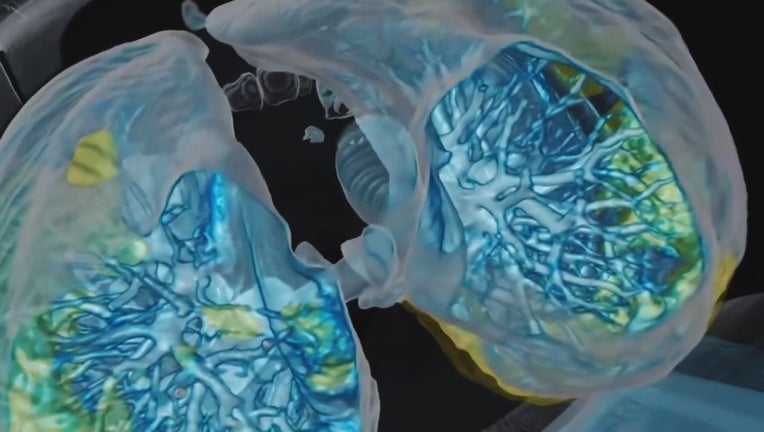Positioning, not ventilation could be key to COVID-19 treatment

An animation of a lung with COVID-19. (George Washington University)
ROCHESTER, Minn. (FOX 9) - From the beginning, it has been one of the tell-tale signs of COVID-19: extremely low blood oxygen saturation levels. It may also be a clue to an effective treatment.
A blood oxygen saturation reading can be taken with a simple oximeter, and for someone healthy, it should be above 95 percent.

Positioning, not ventilation could be key to COVID-19 treatment
From the beginning, it has been one of the tell-tale signs of COVID-19: extremely low blood oxygen saturation levels. It may also be a clue to an effective treatment.
Those who are seriously ill with COVID-19 have blood oxygen saturation levels below 80 percent, some as low as 60.
It is one of the symptoms of Acute Respiratory Syndrome (ARDS), and the treatment of last resort is usually mechanical ventilation, a machine that pushes oxygen into the lungs.
But doctors at Mayo Clinic are researching a different approach: placing patients prone, on their belly, or on their side, while receiving oxygen.
“Many of these patients are profoundly hypoxemic,” said Dr. Ognjen Gajic. “We are talking very low oxygen levels, but initially at least, they are not in distress.”
“If they are turned on their side, sit up, or sleep on their belly, their oxygen level does come up,” said Dr. Ognjen, whose colleagues are conducting the study.
Dr. Ognjen said he has seen about 19 patients with COVID-19, and describes it as a “very patchy disease,” with damaged tissue unevenly distributed in the lungs.
By changing the patients’ position for 16 hours at a time, “the oxygen goes to the better parts of the lung, instead of the worst parts,” said Dr. Ognjen.
In New York City, intensive care unit doctors have taken to social media to argue that hospital protocols should be changed, and patients who would otherwise be intubated and put on ventilators should first be placed in a prone position and given oxygen.
“The patients in front of me are unlike any I’ve seen,” said Dr. Cameron Kyle-Sidell, a critical care doctor in Brooklyn, who said the symptoms are more like altitude sickness.
Dr. Kyle-Sidell told WebMD, it was “as if tens of thousands of my fellow New Yorkers are stuck on a plane at 30,000 feet and the cabin pressure is slowly being let out. These patients are slowly being starved of oxygen.”
The problem is much of the research is from Wuhan, China and has not been peer reviewed, and the U.S. protocols in place for intubation and ventilation have been developed over years.
Dr. Gajic also said in contrast with ventilation, the patients require constant monitoring, a process that is labor intensive.
Mayo Clinic is currently conducting a massive research project with 200 other hospitals to collect details on every COVID-19 patient including symptoms, lab tests, and ventilator settings.
The hope is the database created will allow doctors to develop treatments, protocols, and point to areas for further research.
Until then, doctors around the country are sharing stories of what works in the treatment of COVID-19, and more tragically, what does not.

